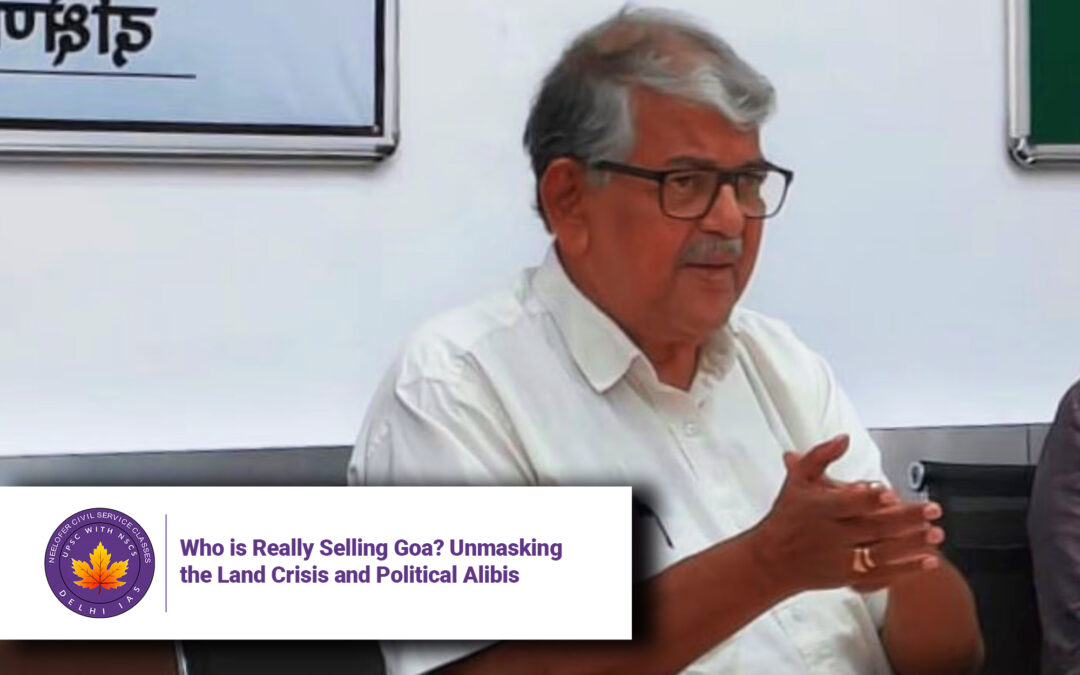Who is Really Selling Goa? Unmasking the Land Crisis and Political Alibis
Introduction
Goa, once a tropical paradise known for its pristine beaches, lush landscapes, and vibrant culture, is undergoing a dramatic transformation. High-rises, luxury resorts, and gated communities are replacing traditional villages, while locals are increasingly priced out of their own homeland.
When questioned about this unchecked development, politicians and elites often deflect blame with a simple retort: “Goans are selling their own land.” But is this narrative accurate, or is it a convenient alibi to mask systemic failures, crony capitalism, and bad governance?
This article explores:
-
Who is really selling Goa’s land?
-
The economic pressures forcing Goans to sell.
-
How the state enables and benefits from land grabs.
-
The myth of “Goans selling out” and who profits from it.
The “Goans Are Selling” Narrative: A Political Smokescreen
1. The Simplistic Blame Game
Politicians and real estate lobbies frequently argue that if Goans didn’t sell, outsiders wouldn’t buy. This oversimplification ignores:
-
Who actually owns the land being sold?
-
Why are they selling?
-
Who is facilitating these deals?
2. The Reality: A Small Elite, Not the Average Goan
The majority of land sales are driven by:
-
Absentee landlords (Diaspora Goans with no active ties to Goa).
-
Old elite families who inherited large tracts but no longer depend on the land.
-
Speculators and politically connected builders who buy cheap and flip properties.
The average Goan—fishermen, farmers, and tenants—often doesn’t even own land to sell.
Why Are Goans Selling? Economic Coercion, Not Greed
1. Collapse of Traditional Livelihoods
-
Farming, fishing, and toddy-tapping are no longer viable due to:
-
Industrial pollution killing fish stocks.
-
Tourism encroachment on agricultural land.
-
Cheap imports undercutting local produce.
-
2. Hostile Land Laws
-
The Goa Escheats, Forfeiture and Bona Vacantia Act (2024) allows the government to seize “unclaimed” land.
-
Tenancy laws are manipulated to evict long-term occupants.
-
Weak zoning regulations permit unchecked construction.
3. Inheritance Disputes & Family Pressures
-
Joint families struggle to manage ancestral properties.
-
NRI Goans prefer quick sales over managing land from abroad.
-
Legal battles make holding onto land risky and expensive.
4. State-Induced Gentrification
Areas like Assagao, Anjuna, Fontainhas, and Parra have seen:
-
Artificial inflation of land prices due to infrastructure “development.”
-
No public consultation on mega-projects.
-
Locals pushed out as rents and taxes skyrocket.
Who Really Benefits? The Politician-Builder Nexus
1. The Role of the State
-
Politicians double as real estate brokers (many MLAs have construction businesses).
-
Laws are tweaked to favor developers over locals.
-
Corruption in approvals (illegal conversions, environmental clearances).
2. The Builder Lobby
-
Outsiders with deep pockets buy land in bulk.
-
Luxury projects cater to tourists and wealthy migrants, not Goans.
-
Land banks are created to manipulate prices.
3. The Media & Narrative Control
-
“Goans are selling” distracts from state failures.
-
Villagers protesting land grabs are labeled “anti-development.”
-
No scrutiny of politicians’ own land dealings.
The Bigger Picture: Systemic Exploitation
1. Climate Change Parallel
Blaming individual Goans for selling land is like blaming citizens for climate change while letting fossil fuel corporations off the hook. The system rewards exploitation.
2. Loss of Goan Identity
-
Cultural erosion as traditional homes become Airbnbs.
-
Language decline as migrant labor replaces local workers.
-
Food security threats as farmland vanishes.
3. Resistance & Legal Battles
-
Goa Bachao Abhiyan fights against mega-projects.
-
Tenants’ rights movements challenge illegal evictions.
-
Courts intervene in some cases (e.g., CRZ violations).
But without political will, these efforts remain fragmented.
Conclusion: Ending the Blame Game
The “Goans are selling” narrative is a smokescreen to avoid accountability. The real culprits are:
Politicians who enable land grabs.
Builders who profit from unchecked construction.
Laws designed to displace locals.
Ordinary Goans are victims, not perpetrators. Until systemic reforms address corruption, fair land policies, and sustainable development, Goa’s soul will keep fading.
5 Q&A on Goa’s Land Crisis
1. Are Goans really selling their land to outsiders?
Answer: Some are, but not the average Goan. Sales are driven by absentee landlords, elites, and speculators—not fishermen or farmers.
2. What is the Goa Escheats Act, and how does it affect land ownership?
Answer: The 2024 law lets the government seize land if owners die without heirs or “abandon” it. Critics fear misuse to grab ancestral properties.
3. Why can’t Goans just refuse to sell?
Answer: Many face economic desperation, legal threats, or inheritance disputes. The system is stacked against small landowners.
4. Who benefits the most from Goa’s land boom?
Answer: Politicians, builders, and real estate mafias. Many MLAs have direct stakes in construction projects.
5. What can be done to protect Goa’s land?
Answer:
-
Stronger tenancy laws to prevent evictions.
-
Transparent land deals with community consent.
-
Punish illegal conversions and CRZ violations.
-
Support sustainable tourism, not concrete jungles.
Final Thought
Goa isn’t being “sold” by its people—it’s being taken. The question isn’t “Why are Goans selling?” but “Who’s allowing the loot?” Until that changes, the blame game will continue, and Goa will keep losing itself.







